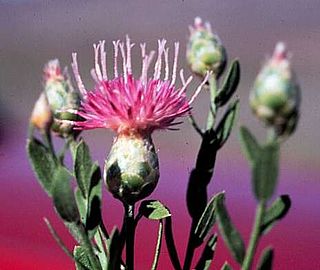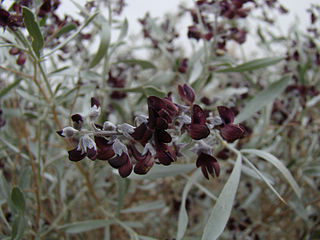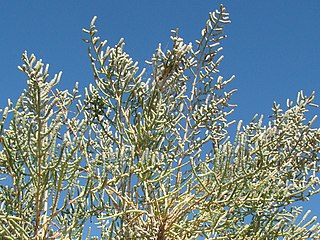| Serratula | |
|---|---|
 | |
| Serratula tinctoria [1] | |
| Scientific classification | |
| Kingdom: | Plantae |
| Clade: | Tracheophytes |
| Clade: | Angiosperms |
| Clade: | Eudicots |
| Clade: | Asterids |
| Order: | Asterales |
| Family: | Asteraceae |
| Subfamily: | Carduoideae |
| Tribe: | Cardueae |
| Subtribe: | Centaureinae |
| Genus: | Serratula L. |
| Type species | |
| Serratula tinctoria | |
| Synonyms [2] | |
| |
Serratula is a genus [3] of plants in the tribe Cardueae within the family Asteraceae native to Eurasia. [4] [5] Plumeless saw-wort is a common name for plants in this genus. [6] Serratula as traditionally defined contains at least two groups: one of which is basal within the subtribe Centaureinae and one of which is derived; the former group can be moved to the genus Klasea . [7]
Various species contain apigenin, luteolin, quercetin, other flavonoids and ecdysteroids. [8]
- Species [2] [9]
- Serratula alata Desf.
- Serratula alatavica C.A.Mey.
- Serratula algida Iljin
- Serratula angulata Kar. & Kir.
- Serratula aphyllopoda Iljin
- Serratula cardunculus (Pall.) Schischk.
- Serratula centauroides L.
- Serratula chanetii H.Lév.
- Serratula chartacea C.Winkl.
- Serratula chinensis S.Moore
- Serratula coriacea Fisch. & C.A.Mey.
- Serratula coronata L.
- Serratula cupuliformis Nakai & Kitag.
- Serratula dissecta Ledeb.
- Serratula dshungarica Iljin
- Serratula erucifolia (L.) Boriss.
- Serratula forrestii Iljin
- Serratula hastifolia Korovin & Kult. ex Iljin
- Serratula kirghisorum Iljin
- Serratula lancifolia Zakirov
- Serratula lyratifolia Schrenk
- Serratula marginata Tausch
- Serratula polycephala Iljin
- Serratula procumbens Regel
- Serratula rugulosa Iljin
- Serratula salsa Pall. ex M.Bieb.
- Serratula scordium Lour.
- Serratula sogdiana Bunge
- Serratula strangulata Iljin
- Serratula suffruticosa Schrenk
- Serratula tilesii Ledeb.
- Serratula tinctoria L.
- Formerly included [2]
Numerous species are now considered members of other genera:
















